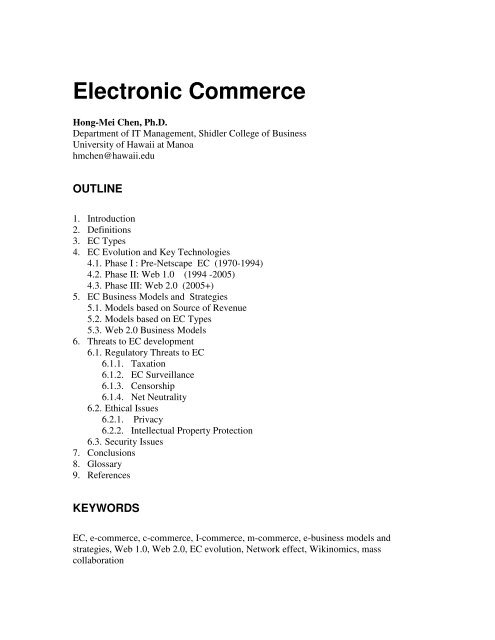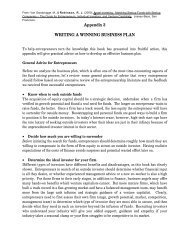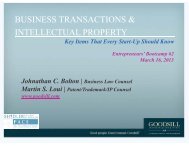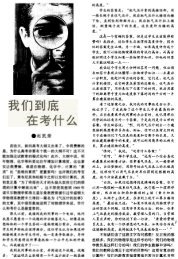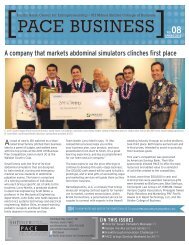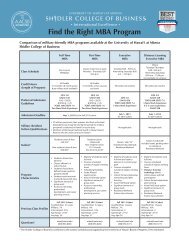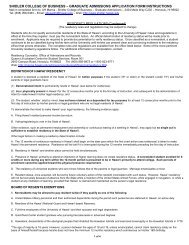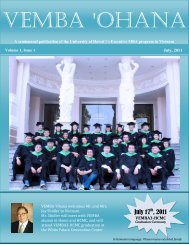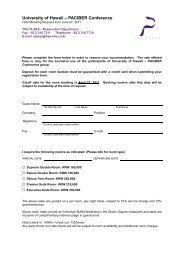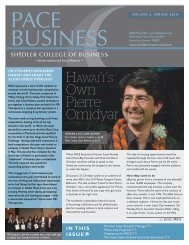Electronic Commerce - Dr. Hong-Mei Chen - University of Hawaii
Electronic Commerce - Dr. Hong-Mei Chen - University of Hawaii
Electronic Commerce - Dr. Hong-Mei Chen - University of Hawaii
Create successful ePaper yourself
Turn your PDF publications into a flip-book with our unique Google optimized e-Paper software.
<strong>Electronic</strong> <strong>Commerce</strong><strong>Hong</strong>-<strong>Mei</strong> <strong>Chen</strong>, Ph.D.Department <strong>of</strong> IT Management, Shidler College <strong>of</strong> Business<strong>University</strong> <strong>of</strong> <strong>Hawaii</strong> at Manoahmchen@hawaii.eduOUTLINE1. Introduction2. Definitions3. EC Types4. EC Evolution and Key Technologies4.1. Phase I : Pre-Netscape EC (1970-1994)4.2. Phase II: Web 1.0 (1994 -2005)4.3. Phase III: Web 2.0 (2005+)5. EC Business Models and Strategies5.1. Models based on Source <strong>of</strong> Revenue5.2. Models based on EC Types5.3. Web 2.0 Business Models6. Threats to EC development6.1. Regulatory Threats to EC6.1.1. Taxation6.1.2. EC Surveillance6.1.3. Censorship6.1.4. Net Neutrality6.2. Ethical Issues6.2.1. Privacy6.2.2. Intellectual Property Protection6.3. Security Issues7. Conclusions8. Glossary9. ReferencesKEYWORDSEC, e-commerce, c-commerce, I-commerce, m-commerce, e-business models andstrategies, Web 1.0, Web 2.0, EC evolution, Network effect, Wikinomics, masscollaboration
ABSTRACT<strong>Electronic</strong> commerce (EC), buying and selling <strong>of</strong> products or services over electronicsystems such as the Internet and other computer networks, has impacted businessesglobally and become a way <strong>of</strong> life for over 1 billion <strong>of</strong> people in the “flat” world today.EC has experienced explosive growth in the last decade. It has evolved through threephases, marked by the enabling technologies from the pre-Netscape phase, to Web 1.0(1994 to 2005), to the Web 2.0+ (2005+) phase today. EC impacts significantly onpeople, businesses, industries and their competitive landscapes. A new industrial order isbeing built by EC and it is <strong>of</strong>fering companies unprecedented opportunities for innovativebusiness models and strategies.Despite regulatory, ethical, and security issuesthreatening EC development, it is expected to grow continuously and substantially.1. Introduction<strong>Electronic</strong> commerce (EC) impacts on how people live, work, learn and play today. Eachday countless individuals—perhaps as many as over 1 billion—around the world enterthe digital realm via the Internet to do various tasks (Internet World Stats, January2008). For example, in any given day, a typical user might send email to Facebook“friends” about his new bike, pay bills on-line, purchase airline tickets, watch CNN news,trade stocks, watch a video on YouTube, Google someone who is interviewing with hiscompany, have a web conference with co-workers at another university, and playcomputer games with someone in Spain.According to the Census Bureau <strong>of</strong> the U.S.Department <strong>of</strong> <strong>Commerce</strong> (2008), the third quarter 2007 EC estimate increased 19.3
percent from the third quarter <strong>of</strong> 2006, and EC is projected to grow at double-digit ratescontinuously, becoming the fastest growing form <strong>of</strong> commerce in the world.For the past decade, the EC technological advancement has been extraordinary andenabled many innovative EC business models.Taking advantage <strong>of</strong> the Web’scharacteristics (including ubiquity, global reach, standard interface, interactivity, andinformation/media richness, etc.), companies are able to mass-customize their products,simulating old-fashion one-to-one marketing using personalization technology such asrecommender systems, with the efficiency <strong>of</strong> serving millions <strong>of</strong> customers all at onceand at all hours.EC is fundamentally transforming businesses practices in manyindustries, creating “Long Tail” (Anderson, 2004) markets for goods and services thatcould not previously be <strong>of</strong>fered or sold in a pr<strong>of</strong>itable way, and opening up markets tonew competitors coming from different locations and industries. Long tail refers to aniche strategy enabled by the low distribution and inventory costs <strong>of</strong> EC. Businesses canrealize significant revenue out <strong>of</strong> selling small volumes <strong>of</strong> larger number <strong>of</strong> hard-to-finditems or "non-hit" items to many customers, instead <strong>of</strong> only selling large volumes <strong>of</strong> alimited number <strong>of</strong> popular items.Value chains are experiencing drastic reconfigurations and business processes are beingautomated or re-engineered as the costs <strong>of</strong> reaching suppliers and customers are reducedand information asymmetries (when one party has more or better information thananother party) are lessened. Efficiencies in the supply chain encourage globalization, andlower prices for consumers. Furthermore, the recent new wave <strong>of</strong> EC technology, termedWeb 2.0, has brought EC to a new era, labeled as Wikinomics. Web 2.0 business models
center around monetizing social networks, mass collaboration or crowd-sourcing. TheWeb creates for companies a new and critical arena for dynamic capabilities—innovativecombinations and linking <strong>of</strong> skills, competences, and resources from inside and outside <strong>of</strong>the firm’s boundaries—but the multi-network power, efficacy, and reach <strong>of</strong> the Web 2.0tools and platforms available to accelerate this transformation is unprecedented (Shuen2008).This chapter aims at providing a broad introduction to EC, focusing on its most recentdevelopment. The chapter is organized as follows. Section 2 discusses variousdefinitions <strong>of</strong> EC. Section 3 describes types <strong>of</strong> EC. Section 4 describes three phases <strong>of</strong>EC evolution: pre-Netscape phase, Web 1.0 Phase (1994 to 2005) and Web 2.0+ Phase(2005+). The key technologies enable the EC evolution will be briefly introduced. ECbusiness models and contemporary strategies will be discussed in Section 5. Regulatory,ethical and security issues threatening EC development will be presented in Section 6.Section 7 concludes this chapter with remarks on the future <strong>of</strong> EC.2. Definitions<strong>Electronic</strong> <strong>Commerce</strong> commonly known as e-commerce or e<strong>Commerce</strong>, isconventionally defined as the buying and selling <strong>of</strong> products or services over electronicsystems such as the Internet and other computer networks. Some define EC broadly asthe equivalent <strong>of</strong> e-business, which refers to the conduct <strong>of</strong> business over computernetworks (Turban et al. 2008).E-business is not limited to commercial activities <strong>of</strong>buying and selling but also non-commercial activities such as collaboration with business
partners, coordination within a firm and servicing customers online. Thus, e-business,with the broadest scope <strong>of</strong> EC, include a range <strong>of</strong> intra-, inter-, and cross-organizationalinteractions over computer networks, going beyond the conventional EC definitionabove.A term that has recently emerged—collaborative commerce or c-commerce—is used tospecifically address a broad category <strong>of</strong> non-sales EC activities where groups orbusinesses communicate or collaborate online. Bititci, Martinez, Albores & Parung (2004,p. 266) observe that collaborative enterprises or networks ‘create new and unique valuepropositions by complementing, integrating and leveraging each other’s capabilities andcompetencies’. C-commerce represents the coming together <strong>of</strong> both IT and social networks:obtaining sustainable competitive advantage from the maximization <strong>of</strong> value adding benefitsobtained by working collaboratively with others via IT. The collaborations between businessand community depend upon the willingness <strong>of</strong> businesses to network and share informationas well as their ability to accept business culture changes. C-commerce demands a newapproach by firms incorporating new relationships, new assumptions, trust and a shift inculture that values partnerships.The pervasive use <strong>of</strong> Internet for e-commerce activity has led to an even narrowerdefinition <strong>of</strong> e-commerce, which is “the use <strong>of</strong> the Internet and the Web to transactbusiness. More formally digitally enabled commercial transactions between and amongorganizations and individuals.”(Laudon and Traver, 2007, p. 10) This is termedInternet EC or I-commerce (Turban et al. 2008, p. 5). Non-Internet EC uses computernetworks such as Value-added networks (VAN, networks that add communications toexisting common carriers) or such company networks as Local Area Network (LAN)
using web technology (e.g., intranet). Currently US Census use Internet EC as their basisfor economic reports on EC. (U.S. Department <strong>of</strong> <strong>Commerce</strong>, 2007)One fast growing area <strong>of</strong> EC is mobile commerce. This refers to the use <strong>of</strong> wirelessnetworks and handheld devices (e.g. a mobile phone, PDA, or smartphone as well asother emerging mobile equipment such as dashtop mobile devices) while on the move toconduct commerce. Mobile commerce (m-commerce or m<strong>Commerce</strong>) is sometimesreferred as U-commerce, owing to the ubiquitous nature <strong>of</strong> its services. Tiwari andBuse (2007, p. 33) define Mobile <strong>Commerce</strong> as “any transaction, involving the transfer<strong>of</strong> ownership or rights to use goods and services, which is initiated and/or completed byusing mobile access to computer-mediated networks with the help <strong>of</strong> an electronicdevice."There are two types <strong>of</strong> EC companies.In contrast to brick-and-mortar (traditionalphysical, old economy) businesses, a company can be a pure-play company in EC, whereno physical storefront exists, such as Amazon.com. A company can be a click-and-brickor click-and-mortar, where the EC channel is in addition to the physical stores. Forexample OfficeDepot.com is an additional commerce channel for the more traditionalOfficeDepot chain <strong>of</strong> stores.3. EC TypesEC is commonly categorized by the relationships among participants:
• Business to Business (B2B):This refers to EC activities among businesses:Businesses selling to or buying from other businesses. For example: Wal-Mart hasextensive B2B relationships with its network <strong>of</strong> distributors. Today about 94%EC volume in the US is in this category according to <strong>Commerce</strong> Departmentstatistics and its annual volume has reached $1.5 trillion in 2005 (U.S.Department <strong>of</strong> <strong>Commerce</strong>, 2007).• Business to Consumer (B2C):This refers to EC activities where onlinebusinesses reach individual consumers.This is the most common type <strong>of</strong> ECthat an individual experiences. A common example is a person ordering fromAmazon.com.E-commerce retail sales in the third quarter <strong>of</strong> 2007 reached US$34.7 billion, accounted for 3.4 percent <strong>of</strong> total sales (U.S. Department <strong>of</strong><strong>Commerce</strong>, 2008).Total retail Internet trade in 2007 is over US$140 billion.Note that these US census numbers are low estimates as they do not account fornon-Internet or non-sales EC activities.• Consumer to Consumer (C2C):Consumers can buy from or sell to otherconsumers directly with the help <strong>of</strong> an online market maker such as eBay.com.• Exchange to Exchange (E2E): An exchange is a public electronic market withmany buyers and sellers. An exchange usually serves a single vertical industrysuch as steel, polymers, or aluminum and focuses on the exchange <strong>of</strong> direct inputsto production and short-term contract or spot purchasing.On the Internet, E2Ehas been used to mean the exchange <strong>of</strong> information or transactions between Websites that themselves serve as exchanges or brokers for goods and servicesbetween businesses. E2E can be thought <strong>of</strong> as a form <strong>of</strong> B2B.
• Government to Citizen (G2C), Government to Business (G2B) and Governmentto Government (G2G): a government buys from or provides services to a citizen(G2C) or a business (G2B) or another government entity (G2G).• Business to Employee (B2E): Companies provide services for their employeessuch as sending in resumes for human resources purposes, filing travel reportsonline or coordinating work schedules.In addition, there are other types <strong>of</strong> EC, such as B2B2C (B2B connecting with B2C).Many such variations can be found.• Peer-to-peer applications (P2P): this actually refers to the P2P technology usedfor afore-mentioned types <strong>of</strong> EC.This technology enables networked peercomputers to share data files and processing with each other directly; there is nointermediary required. Napster.com, which was established to aid Internet usersin finding and sharing online music files, was the most well-known example <strong>of</strong>this type but failed due to legal issues. BitTorrent.com is a more recent example.4. EC Evolution and Key TechnologiesInformation technology (IT) has revolutionized the business landscape worldwide.Theuse <strong>of</strong> EC technologies, including Internet and WWW, has spawned new business modelsand strategies. EC has grown explosively and the evolution <strong>of</strong> EC can be categorizedinto three stages: Pre-Netscape (1970-1994), Web 1.0 (1994-2005), and Web 2.0+(2005+). The definition <strong>of</strong> EC is therefore expanding from a narrow scope (I-commerce)
to broader scope (e-business), as discussed in the previous section, according to thetechnological evolution path. The major time line is depicted in Table 1.Table 1: EC Evolution TimelineEC Phase I 19731990EC Phase II 1994199519981999200020022003Email was invented by Ray Tomlinson <strong>of</strong> BBN.Tim Berners-Lee created the first World Wide Web browserand server on a NeXT computerNetscape released the Navigator browser in October under thecode name Mozilla. Pizza Hut <strong>of</strong>fered pizza ordering on its Webpage. The first online bank opened. Attempts to <strong>of</strong>fer flowerdelivery and magazine subscriptions online. "Adult" materialswere also commercially available, as were cars and bikes. Inlate 1994 Netscape 1.0 introduced SSL encryption which madetransactions secure.Jeff Bezos launched Amazon.com. The first commercial 24 hr.internet only radio stations "Radio HK" and NetRadio startedbroadcasting. Dell and Cisco began to aggressively use theInternet for commercial transactions. eBay was founded bycomputer programmer Pierre Omidyar as AuctionWeb.<strong>Electronic</strong> postal stamps can be purchased and downloaded forprinting from the Web.Business.com was sold for US $7.5 million (it was purchased in1997 for US $150,000); The peer-to-peer filesharing s<strong>of</strong>tware"Napster" was launched; Myspace.com was incepted;Google.com, still in beta, was answering 10,000 search querieseach day.The dot-com bust; Web size estimates surpass 1 billion pages,up from 300 million in 1998; wireless Internet access begins.eBay purchased Paypal for US$1.5 billion.Amazon.com: first-ever full-year pr<strong>of</strong>it announced.EC Phase III2004 MySpace was sold to News corporation (FOX news) for US$580 million.2005 YouTube debuted in Nov. 2005; Facebook.com begins andgains instant popularity; eBay purchases Skype for US $2.6billion on Oct. 14, 2005.
20062008YouTube was purchased by Google for US$1.65 billion onNov. 13, 2006Micros<strong>of</strong>t <strong>of</strong>fered to buy Yahoo.com for $46 billion.4.1 EC phase I: Pre-NetscapeEC Phase I begins with the inception <strong>of</strong> IT use in business and ends with the introduction<strong>of</strong> the Netscape browser on Aug. 1994. EC applications were initially developed in theearly 1970s. These were applications such as <strong>Electronic</strong> Funds Transfer (EFT) wherefunds could be transferred electronically, and EDI (<strong>Electronic</strong> Data Interchange) wheredocuments such as purchase orders, invoices, and electronic payments could betransferred between firms doing business together. Many new EC applications followed,ranging from stock trading to airline ticket reservation systems through EDI. Thesesystems at the time were primarily used to facilitate business transactions via proprietarynetworks, called inter-organizational systems (IOSs).EDI technology continued toevolve into Phase II, where EDI applications could be performed via Internet. This iscalled Internet EDI. However, evidence from wholesalers in 2005 indicates that B2B ECrelies overwhelmingly on proprietary EDI systems (U.S. Department <strong>of</strong> <strong>Commerce</strong>,2008).4.2 EC phase II: Web 1.0The commercial use <strong>of</strong> the Internet, the advent <strong>of</strong> the World Wide Web, the ease <strong>of</strong> use<strong>of</strong> web browsers and other technological advances in the early 1990s brought about
wide-spread use and rapid expansion <strong>of</strong> EC applications—the term ‘electroniccommerce’ was coined at that time. EC Phase II is marked by the introduction <strong>of</strong> thecommercial Netscape browser, coincided with Windows 95 and plug-and-playarchitecture. Previously there had been other browsers, such as Mosaic, which had muchsmaller numbers <strong>of</strong> users.Web browser technology allowed individual users andbusinesses access to different networks using a single type <strong>of</strong> interface and made the Weba viable platform for B2B EC as well as for B2C EC Businesses flocked to the Web,attracted by the ease <strong>of</strong> setting up electronic storefronts and the potential access to aglobal market <strong>of</strong> Internet subscribers. Laudon and Traver (2007) estimate that more $120billion was invested in 12,450 Internet start-up companies between 1998 and 2000, aperiod <strong>of</strong> significant growth in EC. Despite the highly publicized dot-com failures in2000 and 2001, EC sales <strong>of</strong> goods and services to consumers have grown steadily. Anumber <strong>of</strong> e-commerce web sites began to report pr<strong>of</strong>its in 2002 and 2003, includingExpedia, eBay, and Amazon,. Growth in other parts <strong>of</strong> the world, and especially Europe,was equally impressive. Large numbers <strong>of</strong> B2B electronic marketplaces were created tohelp match buyers and sellers in many industries, and by early 2000 more than 750 B2Be-markets were operating worldwide (U.S. Department <strong>of</strong> <strong>Commerce</strong>, 2000).In Phase II, technology for EC platform and applications began to expand and mature,such as payment systems, communication systems and security systems.Significanttechnology-driven business innovation was developed.It took a few years after thelaunch <strong>of</strong> Netscape and many rounds <strong>of</strong> technology improvements for customers tobroadly adopt the Web-based technology for EC, for instance, feeling comfortable usingtheir credit cards online. Established encryption methods such as Secure Sockets Layer
(SSL), a protocol developed by Netscape Communications Corporation, were used toencode credit card numbers and other information to foil would-be thieves. Online orelectronic Customer Relationship Management (CRM) systems started to flourish in late1999 in an attempt to imitate one-to-one marketing as experienced in old-fashioned<strong>of</strong>fline business relationships (<strong>Chen</strong>, <strong>Chen</strong> and Kazman, 2007).One well knownexample <strong>of</strong> CRM personalization s<strong>of</strong>tware is the recommender system pioneered byAmazon.com in 1999. Many interactive tools were <strong>of</strong>fered by businesses during thisphase, such as live chat using VoIP (Voice over IP) technology. Google was still in itsBeta version back in 1999, but in less than 5 years, it has grown to become a verb <strong>of</strong>everyday language, that is “I Googled…”.In addition, the wireless Internet widelyavailable (by 2000) completed the “last-mile” <strong>of</strong> Internet access and enabled morebusiness innovations in m-commerce.EC field in this phase was experiencingconsolidation as companies test different business models and organizational structures.Pure-play EC companies, including Amazon.com, were expanding operations andgenerating increasing sales.Amazon.com finally showed a pr<strong>of</strong>it for the first time in2003. As shown in the timeline, many dotcom company’s valuation have increased fromseveral millions to hundred <strong>of</strong> millions to billions today, all in less than a decade. Yahoowas recently <strong>of</strong>fered a takeover bid <strong>of</strong> $46 Billion by Micros<strong>of</strong>t.Google’s marketcapitalization was over $140 billion in the year 2007.4.3 EC phase III: Web 2.0+Phase III <strong>of</strong> EC evolution is roughly marked by the year <strong>of</strong> 2005. This year heralded thedebut <strong>of</strong> YouTube.com, in Nov. 2005. YouTube was one <strong>of</strong> the fastest growing social
networking sites on the Web, and was ranked the 5th most popular website in 2006, faroutpacing even MySpace's spectacular rate <strong>of</strong> growth. Users upload 70,000 new videosto the site every day and users were watching 100 million videos every day by the end <strong>of</strong>2006. The technology employed—high quality video display with the scalability tomillion <strong>of</strong> users—has been a primary factor in its success. This advanced technologycapability as well as its fast pace <strong>of</strong> adoption, popularity and the influence <strong>of</strong>YouTube.com was a significant indication that a new era <strong>of</strong> EC had begun.New phenomena in this phase have been described by new terms such as masscollaboration, Wikinomics, crowdsourcing, folksonomy, prosumer, mashups, etc. Thesedevelopments have been so numerous and so powerful that they have been described as a“tsunami” by many. The power <strong>of</strong> social networking and its network effect is beginningto have an impact on EC and is quickly being exploited and monetized by corporations.Ordinary people can now control, use, remix, and share information on the Web througha new array <strong>of</strong> technologies: blogs, wikis, podcasts, RSS, social bookmarking, socials<strong>of</strong>tware, etc. Syndication tools like RSS (which means Rich Site Summary or ReallySimple Syndication) enable sites to keep users up to date without requiring them to checkin regularly. RSS is now being used to push not just notices <strong>of</strong> new blog entries, but alsoall kinds <strong>of</strong> data updates, including stock quotes, weather data, and photo availability.Mash-ups allow a site to create new services by combining its content (e.g. maps) withanother site's contents (e.g. one <strong>of</strong> the first mash-ups, HousingMaps.com, showed housesfor sale that by locating them on a map; a mash-up between Craigslist and Google Maps).User tagging <strong>of</strong> content (e.g., folksonomy) such as photos and videos allows it to be
searched and more easily incorporated into other sites (e.g. users' photos from a photosharingsite like Flickr might be brought into a news site to enhance coverage).The phenomenon and array <strong>of</strong> technologies that propelled the development in this phasewas collectively referred to as “Web 2.0,” a term coined by Tim O’Reilly in 2005.According to O'Reilly: "Web 2.0 is the business revolution in the computer industrycaused by the move to the Internet as platform, and an attempt to understand the rules forsuccess on that new platform." (O’Reilly, 2005)O’Reilly argued that the web hadbecome a platform, with s<strong>of</strong>tware above the level <strong>of</strong> a single device, leveraging the power<strong>of</strong> the "Long Tail", and with data as a driving force. Web 2.0 data can be remixed or“mashed up,” <strong>of</strong>ten through Web-service interfaces. According to O'Reilly, Web 2.0 isan “architecture <strong>of</strong> participation” where users can contribute website content to add valuethat creates network effects. Web 2.0 applications are delivered and used by usersentirely through a browser. It includes a richer, more interactive, user-friendly interfacebased on Ajax (Asynchronous JavaScript and XML) or other similar frameworks. Usersown the data on the site and exercise control over that data. Based on Web 2.0principles, the more that users contribute, the more popular and valuable a Web 2.0 sitebecomes. Web 2.0 technologies tend to foster innovation in the assembly <strong>of</strong> systems andsites composed by pulling together features from distributed, independent developers (akind <strong>of</strong> "open source" development and an end to the s<strong>of</strong>tware-adoption cycle (the socalled"perpetual beta"). Web 2.0 technology allegedly encourages lightweight businessmodels enabled by syndication <strong>of</strong> content and <strong>of</strong> service and by ease <strong>of</strong> picking-up byearly adopters. For example, a new service like housingmaps.com was built simply bysnapping together two existing services, that is, ‘innovation by assembly.’
Housingmaps.com has a lightweight business model and it doesn't have a revenue model(yet)--but for many small-scale services like Housingmaps, Google AdSense (or perhapsAmazon associates fees, or both) provides the snap-in equivalent <strong>of</strong> a revenue model.Tim O'Reilly provided examples <strong>of</strong> companies or products that embody these principles<strong>of</strong> Web 2.0-ness (See Table 2).Table 2: Web 1.0 vs. Web 2.0 Examples (2005)Web 1.0 Web 2.0DoubleClick --> Google AdSenseOfoto --> FlickrAkamai --> BitTorrentmp3.com --> NapsterBritannica Online --> Wikipediapersonal websites --> Bloggingevite --> upcoming.org and EVDBdomain name speculation --> search engine optimizationpage views --> cost per clickscreen scraping --> web servicespublishing --> Participationcontent management systems --> Wikisdirectories (taxonomy) --> tagging ("folksonomy")stickiness --> SyndicationIn this age, the power <strong>of</strong> the consumer has risen to a new height (<strong>Chen</strong> & Vargo, 2008).Better collaboration between the masses <strong>of</strong> customers, suppliers, enterprises, partners orcompetitors is becoming an urgent, strategic focus for firms to compete in this new era.5. EC Business Models and StrategiesOne <strong>of</strong> the major characteristics <strong>of</strong> EC is that it enables new ways <strong>of</strong> doing business, thatis, the creation <strong>of</strong> new business models or the reinvention <strong>of</strong> tried-and-true models.
Rappa (2008) defines a business model as the “method <strong>of</strong> doing business by which acompany can sustain itself—that is, generate revenue. The business model spells-outhow a company makes money by specifying where it is positioned in the value chain.”Many definitions (Timmers, 1998; Weill and Vitale, 2001; Afuah and Tucci, 2001;McKay and Marshall,2004) exist for what a business model is, thus resulting in manydifferent classifications and taxonomies <strong>of</strong> EC business models in the research literature.However, different models are sufficient to illustrate the range <strong>of</strong> approaches <strong>of</strong> doingbusiness stimulated by EC capabilities.We have seen many new Internet businessmodels being played out in the Phase II EC and currently Web 2.0 opens up a range <strong>of</strong>new business models based on a fundamentally different view <strong>of</strong> how businesses,customers and partners interact.5.1 EC Business Models based on Source <strong>of</strong> RevenueThe following 9 EC business models and its subtypes (shown in Table3) are the most commonly cited classification by revenue model firstproposed in 1999 by Rappa (2004):1. Brokerage Model. Brokers are market-makers: they bring buyers and sellerstogether and facilitate transactions. Brokers play a frequent role in B2B, B2C andC2C markets. Usually a broker charges a fee or commission for each transaction itenables. The formula for fees can vary.2. Advertising Model. The web advertising model is an extension <strong>of</strong> the traditionalmedia broadcast model. The broadcaster, in this case, a web site, provides content(usually, but not necessarily, for free) and services (like email, IM, blogs) mixed with
advertising messages in the form <strong>of</strong> banner ads. The banner ads may be the major orsole source <strong>of</strong> revenue for the broadcaster. The broadcaster may be a content creatoror a distributor <strong>of</strong> content created elsewhere. The advertising model works best whenthe volume <strong>of</strong> viewer traffic is large or highly specialized.3. Infomediary Model. Data about consumers and their consumption habits arevaluable, especially when that information is carefully analyzed and used to targetmarketing campaigns. Independently collected data about producers and theirproducts are useful to consumers when considering a purchase. Some firms functionas infomediaries (information intermediaries) assisting buyers and/or sellersunderstand a given market.4. Merchant Model. These are wholesalers and retailers <strong>of</strong> goods and services. Salesmay be made based on list prices or through auction.5. Manufacturer (Direct) Model. The manufacturer or "direct model", it is predicatedon the power <strong>of</strong> the web to allow a manufacturer (i.e., a company that creates aproduct or service) to reach buyers directly and thereby compress the distributionchannel. The manufacturer model can be based on efficiency, improved customerservice, and a better understanding <strong>of</strong> customer preferences.6. Affiliate Model. In contrast to the generalized portal, which seeks to drive a highvolume <strong>of</strong> traffic to one site, the affiliate model, provides purchase opportunitieswherever people may be surfing. It does this by <strong>of</strong>fering financial incentives (in theform <strong>of</strong> a percentage <strong>of</strong> revenue) to affiliated partner sites. The affiliates providepurchase-point click-through to the merchant. It is a pay-for-performance model -- ifan affiliate does not generate sales, it represents no cost to the merchant. The affiliate
model is inherently well-suited to the web, which explains its popularity. Variationsinclude banner exchange, pay-per-click, and revenue sharing programs.7. Community Model. The viability <strong>of</strong> the community model is based on user loyalty.Users have a high investment in both time and emotion in these communities.Revenue can be based on the sale <strong>of</strong> ancillary products and services or voluntarycontributions; or revenue may be tied to contextual advertising and subscriptions forpremium services. The Internet is inherently suited to community business modelsand today this is one <strong>of</strong> the more fertile areas <strong>of</strong> development, as seen in rise <strong>of</strong> socialnetworking.8. Subscription Model. Users are charged a periodic -- daily, monthly or annual -- feeto subscribe to a service. It is not uncommon for sites to combine free content with"premium" (i.e., subscriber- or member-only) content. Subscription fees are incurredirrespective <strong>of</strong> actual usage rates. Subscription and advertising models are frequentlycombined.9. Utility Model. The utility or "on-demand" model is based on metering usage, or a"pay as you go" approach. Unlike subscriber services, metered services are based onactual usage rates.Table 3. Rappa’s EC Business Models based on Source <strong>of</strong> Revenue (reproduced withpermission from the author; Rappa 2004)Type <strong>of</strong> ModelBrokerageModelSubtypes and examplesMarketplace Exchange -- <strong>of</strong>fers a full range <strong>of</strong> services covering the transactionprocess, from market assessment to negotiation and fulfillment. Exchanges operateindependently or are backed by an industry consortium. [Orbitz, ChemConnect]Buy/Sell Fulfillment -- takes customer orders to buy or sell a product or service,including terms like price and delivery. [CarsDirect, Respond.com]
Demand Collection System -- the patented "name-your-price" model pioneered byPriceline.com. Prospective buyer makes a final (binding) bid for a specified good orservice, and the broker arranges fulfillment. [Priceline.com]Auction Broker -- conducts auctions for sellers (individuals or merchants). Brokercharges the seller a listing fee and commission scaled with the value <strong>of</strong> the transaction.Auctions vary widely in terms <strong>of</strong> the <strong>of</strong>fering and bidding rules. [eBay]Transaction Broker -- provides a third-party payment mechanism for buyers andsellers to settle a transaction. [PayPal, Escrow.com]Distributor -- is a catalog operation that connects a large number <strong>of</strong> productmanufacturers with volume and retail buyers. Broker facilitates business transactionsbetween franchised distributors and their trading partners.Search Agent -- a s<strong>of</strong>tware agent or "robot" used to search-out the price andavailability for a good or service specified by the buyer, or to locate hard to findinformation.Virtual Marketplace -- or virtual mall, a hosting service for online merchants thatcharges setup, monthly listing, and/or transaction fees. May also provide automatedtransaction and relationship marketing services. [zShops and Merchant Services atAmazon.com]AdvertisingModelInfomediaryModelMerchantModelManufacturer(Direct) ModelPortal -- usually a search engine that may include varied content or services. A highvolume <strong>of</strong> user traffic makes advertising pr<strong>of</strong>itable and permits further diversification <strong>of</strong>site services. A personalized portal allows customization <strong>of</strong> the interface and content tothe user. A niche portal cultivates a well-defined user demographic. [Yahoo!]Classifieds -- list items for sale or wanted for purchase. Listing fees are common, butthere also may be a membership fee. [Monster.com, Craigslist, Match.com]User Registration -- content-based sites that are free to access but require users toregister and provide demographic data. Registration allows inter-session tracking <strong>of</strong> usersurfing habits and thereby generates data <strong>of</strong> potential value in targeted advertisingcampaigns. [NYTimes]Query-based Paid Placement -- sells favorable link positioning (i.e., sponsored links)or advertising keyed to particular search terms in a user query, such as Overture'strademark "pay-for-performance" model. [Google, Overture]Contextual Advertising / Behavioral Marketing -- freeware developers who bundleadware with their product. For example, a browser extension that automatesauthentication and form fill-ins, also delivers advertising links or pop-ups as the usersurfs the web. Contextual advertisers can sell targeted advertising based on an individualuser's surfing activity.Content-Targeted Advertising -- pioneered by Google, it extends the precision <strong>of</strong>search advertising to the rest <strong>of</strong> the web. Google identifies the meaning <strong>of</strong> a web pageand then automatically delivers relevant ads when a user visits that page. [Google]Intromercials -- animated full-screen ads placed at the entry <strong>of</strong> a site before a userreaches the intended content. [CBS MarketWatch]Ultramercials -- interactive online ads that require the user to respond intermittently inorder to wade through the message before reaching the intended content. [Salon incooperation with Mercedes-Benz]Advertising Networks -- feed banner ads to a network <strong>of</strong> member sites, therebyenabling advertisers to deploy large marketing campaigns. Ad networks collect dataabout web users that can be used to analyze marketing effectiveness. [DoubleClick]Audience Measurement Services -- online audience market research agencies.[Nielsen//Netratings]Incentive Marketing -- customer loyalty program that provides incentives to customerssuch as redeemable points or coupons for making purchases from associated retailers.Data collected about users is sold for targeted advertising. [Coolsavings]Metamediary -- facilitates transactions between buyer and sellers by providingcomprehensive information and ancillary services, without being involved in the actualexchange <strong>of</strong> goods or services between the parties. [Edmunds]Virtual Merchant --or e-tailer, is a retail merchant that operates solely over the web.[Amazon.com]Catalog Merchant -- mail-order business with a web-based catalog. Combines mail,telephone and online ordering. [Lands' End]Click and Mortar -- traditional brick-and-mortar retail establishment with webstorefront. [Barnes & Noble]Bit Vendor -- a merchant that deals strictly in digital products and services and, in itspurest form, conducts both sales and distribution over the web. [Apple iTunes MusicStore]Purchase -- the sale <strong>of</strong> a product in which the right <strong>of</strong> ownership is transferred to thebuyer.
Turban et.al. (2008) list 20 commonly used EC business models, mixing source <strong>of</strong>revenue, EC types and competitive strategies in their classification. For instance, theDeep discounting model implies low cost strategy, the Product and ServiceCustomization model implies a differentiation strategy, and the Direct Marketing, theViral Marketing and the Affiliate Marketing models are straightforward marketingstrategies.5.3 Web 2.0 Business ModelsThe above models included Web 2.0 business models in the traditional categories <strong>of</strong>“community model” or viral marketing.Tapscott and Williams (2007) argue in theirbook Wikinomics: How Mass Collaboration Changes Everything that the economy <strong>of</strong>"the new web" depends on mass collaboration. The prospective Internet-based economythat they term "Wikinomics" depends on the principles <strong>of</strong> openness, peering, sharing, andacting globally. They have explicitly identified seven Web 2.0 business-models with highlevel strategies embedded, summarized in Table 4 below.Table 4. Web 2.0 Business Models (Tapscott and Williams, 2007)Model Description ExamplesPeer pioneersIdeagorasProsumersSelf-organizing, voluntary, nonmonetarycommunities that Collaboratively produceopen source goods and services.Generating ideas for innovations with thehelp <strong>of</strong> social networking platforms thatbring together questions and solutions toproblems.Based on the principle <strong>of</strong> user generatedcontent and products.Consumers become producers.Linux, Wikipedia,IBM support for LinuxNetwork, Eureka Medical,YourEncore, Innovation RelayCenters, P&G, yet2.comSecond Life, Lego Mindstorms, MusicMashups, Creative Commons,YouTube, Slashdot, digg
NewAlexandriansPlatforms forParticipationGlobal PlantFloorWiki WorkplaceCollaborative open accessproduction <strong>of</strong>scientific knowledgeCreation <strong>of</strong> business partnerships byopening <strong>of</strong> s<strong>of</strong>tware services and databasesvia an application programming interface(API). Existing platforms or applications arecombined or integrated with other ones.Physical products are modularized andproduction is globally outsourced so thatproducts are co- created by manycontributing actors that work in parallelUsage <strong>of</strong> blogs, wikis, chatrooms, peertopeer-networks,podcasts, etc. acrossdepartmental and organizational boundariesin order to collaborate and form ad hoccommunities.Google Print, arXiv, Human GenomeProject, Single NucleotidePolymorphisms (SNP) Consortium,Intel’s Open <strong>University</strong> NetworkHousingMaps, CheapGas, Developercommunities <strong>of</strong> eBay, Google,Amazon; PeopleFinder, BBC CreativeArchive, Amazon, Scorecard,Neighborhood Knowledge CaliforniaBMW, Lifan, BoeingGeek Squad, Best Buy, Socialtext,Google 20% ruleThese models <strong>of</strong> competition all share one thing in common: “These new forms . . .enable firms to harvest external knowledge, resources, and scale that were all previouslyimpossible. Whether your business is closer to Boeing or P&G, or more like YouTube orFlickr, there are vast pools <strong>of</strong> external talent that you can tap with the right approach.Companies that adopt these models can drive important changes in their industries andrewrite the rules <strong>of</strong> competition” (p. 269).These models are not so different from theones shown earlier in this section. The difference is that Wikinomics strategies are moresubtle in exploiting free or cheap labor as the contributors truly enjoy their tasks; theterm “crowdsourcing” is the one <strong>of</strong> the terms that describes these strategies. “Companiescan design and assemble products with their customers, and in some cases customers cando the majority <strong>of</strong> the value creation” (p. 289).In sum, EC has enabled new business models and changed the competitive landscape forall kinds <strong>of</strong> companies—and it continues to change the landscape. Companies may beforced to—and can much more easily than ever before—change or combine differentbusiness models to align with technological advancements and to leverage firm
against such measures, arguing that it would impose a heavy burden on them. In 1998,congress passed the Internet Tax Freedom Act, which placed a moratorium on “multipleor discriminatory taxes on electronic commerce” as well as on Internet access. Themoratorium has since been extended three times, in 2001, 2004 and 2007 to extend foranother 7 years. The European Union (EU) already has a method for taxing business-tobusinesstransactions over the Internet. EU companies are required to collect tax on salesbut U.S. companies are not.This has given American companies a huge edge intransnational EC.6.1. 2 EC SurveillanceGovernment or law enforcement authorities have long claimed the right under numerousstatutes to monitor any form <strong>of</strong> electronic communications pursuant to court orders andjudicial review.The USA PATRIOT Act, introduced after the Sept. 11th terroristattacks in 200l, strengthened the ability <strong>of</strong> law enforcement agencies to monitor EC userswithout their knowledge. In 2004, a Privacy and Civil Liberties Oversight Board in the<strong>of</strong>fice <strong>of</strong> the President was created to ensure anti-terrorism laws do not decimate otherprivacy protection laws.6.1.3 CensorshipCensorship is the governmental attempt to control Internet traffic and limit citizens fromviewing its contents.For instance, China and North Korea set strict guidelines on whatcan be viewed and certain key words and topics are blocked as search terms. In 1998,the US Congress passed the Children’s Online Protection Act (COPA) which made it a
felony criminal <strong>of</strong>fense to communicate for ‘commercial purposes . . . any materialharmful to minors.” In 2001, the Children’s Internet Protection Act (CIPA) requiredschools and libraries in the United States to install “technology protection measures”(filtering s<strong>of</strong>tware) in an effort to shield children from pornography. In many countries,the debate continues about the rights <strong>of</strong> the individual versus the right <strong>of</strong> the society.6.1.4 Net NeutralityCurrently, data sent over the Internet is handled in a neutral manner. All traffic is treatedthe same way. ISPs and telephone companies have argued for prioritization as traditionalInternet traffic (e.g., e-mail) suffers due to competition with high bandwidth applications,such as video. For example, they argue that YouTube.com is not paying their fair sharefor their high bandwidth video application and should be de-prioritized in the net traffic.This threatens to bring in more regulations on Net usage.6. 2 Ethical issues6.2.1 PrivacyEC sites routinely collect a variety <strong>of</strong> information from or about consumers who visittheir sites and make purchases (pr<strong>of</strong>iling) to understand the customer better (behaviortargeting) and to implement their personalization strategies.The more personal orprecise the information collected, the more individual privacy is potentially invaded. Toput customers at ease, many EC stores post “privacy statements” that explain their policy<strong>of</strong> sharing (or not sharing) customer information with other businesses. This privacypolicy may include refusing to give the customer’s name and e-mail address to
companies that send unsolicited and unwanted commercial e-mail messages, <strong>of</strong>ten knownas junk mail or spam.In 2003 the U.S. Congress passed legislation designed to curbspam. The new law made it illegal for senders <strong>of</strong> unsolicited commercial e-mail todisguise their identity by using false return addresses or misleading subject lines. The lawalso prohibited the gathering <strong>of</strong> e-mail addresses from Web sites. Sponsors <strong>of</strong> thelegislation estimated that the incredible growth in spam, representing about half <strong>of</strong> all e-mails, cost Internet access providers $9 billion annually in technology-related expensesnecessary to handle the increased volume <strong>of</strong> mail. Clogged in-boxes also annoyedconsumers and made it difficult to distinguish between solicited and unsolicitedcommercial e-mail messages.There are privacy-enhancing technologies for protecting user privacy during interactionswith websites.Most <strong>of</strong> these tools emphasize security – the ability <strong>of</strong> individuals toprotect their communications and files from illegitimate snoopers.Others includespyware blockers, cookie blockers, pop-up controls on browsers, anonymous surfing,disk/file erasing programs, policy generators, privacy policy reader, public keyencryption, etc.This issue continues to be a tug-<strong>of</strong>-war between advertisers andmarketers versus consumers.6.2.2 Intellectual property rightsIntellectual property encompasses all the tangible and intangible products <strong>of</strong> the humanmind. Common types <strong>of</strong> intellectual property include copyrights, patents and trademarks.Digital media differs from books and other media in terms <strong>of</strong> ease <strong>of</strong> replication,transmission and alteration, and the difficulty in classifying a s<strong>of</strong>tware work as
establishing uniqueness. EC permits millions <strong>of</strong> people to make perfect copies <strong>of</strong> digitalworks. The Digital Millennium Copyright Act (DMCA) <strong>of</strong> 1998 is the first major effortto adjust copyright laws to the Internet age.Napster failed due to copyright issues andYouTube is still in court for similar issues, when customers violate copyrights. ECcompanies are relying on technology to detecting user violations. For instance, YouTubeuses robots to scan the “tags” <strong>of</strong> the user-submitted contents for violations. DigitalRights Management (DRM) systems are technology-enabled protection measures thatallow a vendor <strong>of</strong> digital content to control the materials and restrict their usage. Forinstance, Apple limits a song downloaded from their iTunes store to be copied up to 5times by using a proprietary file format.Some s<strong>of</strong>tware self-destructs after a specificnumber <strong>of</strong> uses. However, DRM systems may restrict the fair (non-commercial) uses <strong>of</strong>material by individuals and it requires the users to reveal their identity, which may causeprivacy concerns.Patents are very different from copyrights because patents protect an idea itself, and notjust the expression <strong>of</strong> an idea. In 1998, a legal decision allowed “business method”patents to be conferred.For instance, Amazon.com patented one-click purchasing in1999; and Priceline.com patented buyer-driven “name your price” sales in 1999.Priceline sued Micros<strong>of</strong>t and Expedia for copying its patented business methods and itwon.In August 2005 Research In Motion Corporation, the creator <strong>of</strong> the BlackBerryhandheld device, was ordered to pay NTP corporation, a patent company, $53.7 millionin damages. The two companies settled outside the court for $612.5 million in March <strong>of</strong>2006.
Trademarks are used to identify and distinguish goods and to indicate their source. InNov. 1999, the Anticybersquatting Consumer Protection Act (ACPA) was passed in theU.S. Congress.ACPA creates civil penalties for anyone who registers an Internetdomain name that is identical, confusingly similar or “dilutive” <strong>of</strong> a trademark.Itproscribes using “bad faith” domain names to extort money from the owners <strong>of</strong> theexisting trademark (cybersquatting) or using the bad faith domain to divert Web traffic tothe bad faith domain that could harm the good will represented by the trademark, createmarket confusion, tarnish or disparage the mark (cyberpiracy).There are debates about how IP laws might impede human progress, including ECdevelopment.There are problems as to how effectively the law can be enforced andmany are concerned about the high price that society would pay for protecting intellectualproperty.6.3 Security IssuesIn the earliest years <strong>of</strong> EC, fears that credit card information would be intercepted whilein transit over the Internet prompted most online stores to implement secure serversrelying on the Secure Sockets Layer (SSL) transmission. EC security today involvesmuch more than just securing transmissions but also protecting against fraud and othercrimes. EC fraud has grown even faster than EC itself.Fraudulent orders representabout 1% <strong>of</strong> incoming B2C orders. A common fraud scheme is “Phishing”: using emailsor pop-up messages to deceive victims into disclosing sensitive information such as
passwords.Extortion rings have pried hundreds <strong>of</strong> thousands <strong>of</strong> dollars from onlinesports betting Web sites. Any site refusing to pay protection fees was threatened withZombie computers, which are computers taken over by hackers and then used to attackother computers. Fake escrow company websites steal buyers’ deposits. Click fraud is acommon concern for advertisers and search vendors alike.Click fraud scams anddeceptions inflate advertising bills for thousands <strong>of</strong> companies <strong>of</strong> all sizes by the use <strong>of</strong>online robots programmed to click on advertisers’ links.Major crimes such as stealing customer information or credit card numbers from e-tailors’ databases have caused many consumers to worry.One critical EC securitychallenge is to authenticate both consumers and online stores, preserve the confidentiality<strong>of</strong> information related to online transactions, and to ensure the integrity <strong>of</strong> transactionrelatedinformation. Currently, there are consumer protection laws, third-party Assuranceservices such as TRUSTe, Web Trust, etc.Many advanced technologies forauthentication—such as two-factor biometric controls for online transactions—areimplemented.Security measures impose inconvenience on consumers (such as theprolonged login-in process for authentication) and additional costs for business, allconstraining EC development.7. CONCLUSIONSThis chapter has provided a broad overview <strong>of</strong> EC including its key concepts and itsevolution through three phases: Pre-Netscape, Web 1.0 and Web 2.0+. We arewitnessing a new EC era (EC Phase III) that was never imagined before. With powerful
Web 2.0 technology, the power <strong>of</strong> consumers has risen and a new industry order is beingbuilt. We introduced new business models and strategies which are enabled by advancedEC technologies. We then examined critical regulatory (e.g., taxation, EC surveillance,censorship and Net neutrality), ethical (e.g., privacy and intellectual property) andsecurity issues that impact on future EC development.EC is expected to grow continuously and many believe that Phase III is just the beginning<strong>of</strong> yet another revolution.With the optimism surrounding the future <strong>of</strong> EC, newtechnology concepts, tentative termed Web 3.0 as the evolutionary stage <strong>of</strong> the Web thatfollows Web 2.0, is starting to form (Borland, 2007). Currently, the technical and socialpossibility for realizing Web 3.0 is still highly speculative and views surrounding futureWeb 3.0 development vary greatly.Nonetheless, it is believed that Web 3.0 or nextgeneration EC technology would extend what we see today (Web 2.0) to be even moreintelligent and more portable, to provide more personal, faster and far-flung connectivity,more powerful search engines, new Web services that work entirely within a browserwindow, and more clout for everyday people. Regulatory, ethical and security issues thatthreaten EC development will continue to be debated and new EC threats will continue toarise as EC continues to break new ground.GLOSSARYAuthentication. The process <strong>of</strong> confirming user identity or data origin and integrity.
Collaborative commerce or c-commerce. A broad category <strong>of</strong> non-sales electroniccommerce activities where groups or businesses communicate or collaborate online.Crowdsourcing. Use <strong>of</strong> everyday people as cheap labor force.E-business. The conduct <strong>of</strong> business over computer networks<strong>Electronic</strong> <strong>Commerce</strong> (e-commerce or e<strong>Commerce</strong>). The buying and selling <strong>of</strong>products or services over electronic systems such as the Internet and other computernetworks; can be as broad as e-business and as narrow as Internet <strong>Commerce</strong>.EDI. <strong>Electronic</strong> Document Interchange; s<strong>of</strong>tware application for transmitting businessdocuments over computer networks automatically.Folksonomy. Taxonomy provided by users or website content tagged by “folks” orusers.Internet EC or I-commerce. The use <strong>of</strong> the Internet and the Web to transact business.More formally digitally enabled commercial transactions between and amongorganizations and individuals.Long tail. The consumer demographic that buys hard-to-find items or "non-hit" itemswhich are in the “long tail” <strong>of</strong> a statistical distribution.Mashups. A web application that combines data and/or functionality from more thanone source.
Mobile commerce (m-commerce or m<strong>Commerce</strong>). Any transaction, involving thetransfer <strong>of</strong> ownership or rights to use goods and services, which is initiated and/orcompleted by using mobile access to computer-mediated networks with the help <strong>of</strong> anelectronic device.Mass collaboration. A form <strong>of</strong> collective action that occurs when large numbers <strong>of</strong>people work independently on a single project, <strong>of</strong>ten modular in its nature. Such projectstypically take place on the internet using social s<strong>of</strong>tware and computer-supportedcollaboration tools such as wiki technologies.Network effect. The value <strong>of</strong> a good or service increases as more people use that goodor service.RSS. Rich Site Summary or Really Simple Syndication; it enable sites to keep users upto date without requiring them to check in regularly.Prosumer. Producer and Consumer is the same person; a customer who contributes tothe creation <strong>of</strong> the products or services he/she then consumes.Wikinomics. Internet-based economy that depends on mass collaboration based on theprinciples <strong>of</strong> openness, peering, sharing, and acting globally.U-commerce. Same as Mobile <strong>Commerce</strong>; the name refers the ubiquitous (anywhereany time) nature <strong>of</strong> its services.
REFERENCESAfuah, A. and C. Tucci (2001). Internet Business Models and Strategies: Text and Cases.New York, NY: McGraw-Hill Irwin.Anderson, C. (2006). The Long Tail: Why the Future <strong>of</strong> Business is Selling Less <strong>of</strong> More.New York: Hyperion.Borland, J. (2007) “A Smarter Web.” www.technologyreview.com, March 12.http://www.technologyreview.com/Infotech/18306/page1/ (Accessed Feb. 8, 2008)Bititci, U., Martinez, V., Albores, P. and Parung, J. (2004).‘Creating and managing valuein collaborative networks’, International Journal <strong>of</strong> Physical Distribution and LogisticsManagement, vol 34(3),251-268.<strong>Chen</strong> H., <strong>Chen</strong> Q., and Kazman R. (2007) “The Affective and Cognitive Impacts <strong>of</strong>Perceived Touch on Online Cstomers’ Intention to Return in the Web-based eCRMenvironment,” Journal <strong>of</strong> <strong>Electronic</strong> <strong>Commerce</strong> in Organizations, 5(1), 69-91, January-March.<strong>Chen</strong> H. and Vargo S. L. “An Alternate Logic for <strong>Electronic</strong> Customer RelationshipManagement.”Special issue on Marketing Transformation to the New e-BusinessEnvironment: Emerging Trends, Approaches and Challenges, International Journal <strong>of</strong>Business Environment, vol. 2(2): 116-132, 2008.CNN Money (2006). “BlackBerry maker, NTP ink $612 million settlement
Research in Motion averts shutdown <strong>of</strong> wireless e-mail service, announces fourth-quarterwarning.” March 3, 2006: 7:29 PM.http://money.cnn.com/2006/03/03/technology/rimm_ntp/ (Accessed: Jan. 31, 2008)Friedman, T. L. (2006) The World is Flat: a Brief History <strong>of</strong> the Twenty-First Century,New York: Farrar, Straus and Giroux.Internet World Stats (2008). “1,319,520,109 Internet users in the world Internet byDecember 2007, a penetration rate <strong>of</strong> 20.0 % worldwide.”http://www.internetworldstats.com/ (Accessed Feb. 8, 2008)Laudon, K. and C. Traver (2007). E-commerce: Business, technology, society, 3 rdEdition. Boston: Addison-Wesley.McKay, J., and P. Marshall (2004). Strategic Management <strong>of</strong> E-business, Milton, Qld.,Australia: John Wiley and Sons, 2004.O'Reilly, T. (2005). “What is Web 2.0? Design patterns and business models for the nextgeneration <strong>of</strong> s<strong>of</strong>tware.”http://www.oreillynet.com/pub/a/oreilly/tim/news/2005/09/30/what-is-web-20.html(Accessed: January, 2008)Rappa, M. (2004). "The Utility Business Model and the Future <strong>of</strong> Computing Services,"IBM Systems Journal, Vol. 43, No. 1, pp. 32-42.(An updated version <strong>of</strong> Rappa's business model taxonomy is maintained on the web athttp://digitalenterprise.org.)
Shuen A. (2008). The Web 2.0 Strategy Guide: Making Web 2.0 Work, O'Reilly Media.Surowiecki, J. (2004) The Wisdom <strong>of</strong> Crowds: Why the Many are Smarter than the Fewand How Collective Wisdom Shapes Business, Economies, Societies, and Nations,Doubleday.Tapscott D. and A. D. Williams (2007), Wikinomics: How Mass Collaboration ChangesEverything, New York: Penguin.Timmers, P. (1998). “Business models for electronic markets,” <strong>Electronic</strong> Markets, 8 (2),3-8.Tiwari, R. and Buse, S. (2007): The Mobile <strong>Commerce</strong> Prospects: A Strategic Analysis <strong>of</strong>Opportunities in the Banking Sector, Hamburg: Hamburg <strong>University</strong> Press.Turban, E., King, D., McKay, J., Marshall P., Lee, J., & Viehland, D. (2008). <strong>Electronic</strong><strong>Commerce</strong> 2008: A Managerial Perspective. Upper Saddle River, NJ: Prentice-Hall.US Department <strong>of</strong> <strong>Commerce</strong> (2000). Digital economy 2000. US Department <strong>of</strong><strong>Commerce</strong>. https://www.esa.doc.gov/Reports/DIGITAL.pdf (Accessed: July 6, 2006)U.S. Department <strong>of</strong> <strong>Commerce</strong> (2007). 2005 e-commerce multi-sector report.U.S.Census Bureau E-Stats.http://www.census.gov/eos/www/2005/2005reportfinal.pdf(Accessed: Jan. 31, 2008)
U.S. Department <strong>of</strong> <strong>Commerce</strong>. (2008). Quarterly retail e-commerce sales: 3rd Quarter2007. http://www.census.gov/mrts/www/data/html/07Q3.html (Accessed: Jan. 31,2008)


